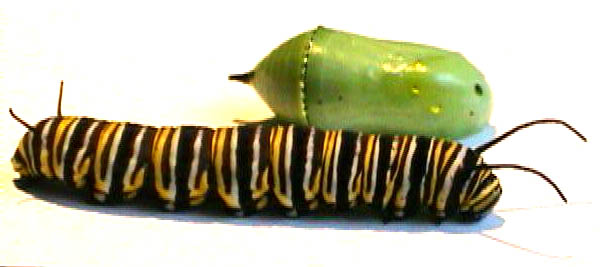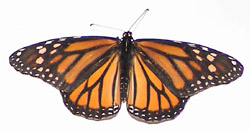
Presented by: Glorious-Butterfly.com

Presented by: Glorious-Butterfly.com
Danaus Plexippus is the scientific name for the Monarch Butterfly. Monarchs can be found on all continents wherever milkweed plants are except the polar regions. Eastern Monarchs spend their winter high in the Mountains located west of Mexico City. Western monarchs are found from the Rockies to the Pacific Ocean and spend the winter months in several areas along the coast of southern California. With a wingspan up to 4 3/4 inches, Monarch butterflies are among the largest and most beautiful butterflies in North America.
The Monarch is one of the longest migrating creatures on Earth. Beginning in August, over 200 million eastern monarchs (those living from the Rockies to the Atlantic Ocean) migrate from their summer feeding and mating grounds in Mexico, where they spend the winter before returning to the United States in late February and March to begin the cycle of life again. In all the monarchs will travel over 3,000 miles as a group over several generations each year. While one Monarch will not make the 3,000 mile trip it will do its part to eat milkweed, mate and continue the cycle its children, grand children, great grand children and great great grandchildren will ultimately finish. The Monarch knows instinctively where to go and how to get there. It is still a mystery exactly how this information is passed on. Monarchs live in all states and reproduce wherever they can find enough Milkweed to support their young. Monarchs are not pests and will not eat anything but Milkweed. They do not hurt crops, ornamental trees or in any way upset the balance of Nature in areas they are introduced. Monarchs are the State Butterfly of Alabama, Idaho, Illinois, Texas, West Virginia and Minnesota.
The life span of an adult Monarch is normally 4 to 8 weeks, except for those that enter diapause (delayed sexual maturity) and migrate to Mexico to spend their winter vacation. Those individuals can live up to 8 or 9 months.
Monarchs are not as plentiful as they were years ago, the use of insecticides and herbicides has eliminated much of their habitat. The milkweed that, the Monarch depends upon for survival, is disappearing as meadows and prairie are developed. While the winter population in Mexico numbers 200 to 400 million, many feel the Monarch may not survive. In 1992 about 70% of these wintering Monarchs in Mexico froze to death as a result of three days of rain and sub freezing conditions. This was an enormous tragedy for our friends the Monarch and they have not been seen again in many Northern regions. Habitat must be protected now, before we see the day when this miracle of nature is only a memory. We include Milkweed seeds with every order and have Free seeds for you if you send us a self addressed stamped envelope. The Monarchs and many butterfly species need your help. Please plant seeds and ensure their survival. Planting new habitat will not only help butterflies around your home but will help butterflies reach others who without your assistance would not see a Monarch. One seed can change the world, we need you to plant it.
To get more plants or other items please visit our store. CLICK HERE
You Can fix a butterfly's wing! Hospital link +
Advanced Caterpillar raising information "Answers to your questions"
Adopt
a FREE Online Butterfly "The entire lifecycle egg eto adult
!!! Awesome educational experience.
Science Fair Projects, Experiments and Ideas
Monarchs make outstanding Science Fair subjects with many possible topics for study.
These include but are not limited to:
Life Cycle
The Monarchs begin life as tiny, off-white eggs laid on milkweed plants. The eggs hatch after 4 or 5 days, and the caterpillars that emerge eat a diet of milkweed leaves for 18 to 20 days. These caterpillars will feed solely on milkweed and eat enormous quantities as they grow. They will grow to 2,700 times their original size in only two weeks, molting five times in the process (shedding their skin to grow). Once fully grown, the caterpillar rests for a day then hangs upside down. Within a few hours this caterpillar miraculously turns into a green chrysalis. This case is emerald green and ringed with golden dots. For 10 to 12 days, the caterpillar inside its chrysalis goes through an amazing metamorphosis and emerges as something completely different. See the entire lifecycle CLICK HERE.
 |
 |
|
Monarch
Egg on mid sized Milkweed Leaf |
Fat Caterpillar
20 leaves later |
What Sex is My Butterfly?
It is easy to find out; just ask a Monarch for its library card. Or you could check the following; The male has two black dots on its lower wings and the female has thicker black vein lines. The male is usually larger as well. Study these pictures and teach your friends.
 |
|
|
Male
|
Female |
OK, maybe you already knew that fact; but did you know that you can tell the sex of your Monarch before it emerges from the chrysalis? You can amaze your friends, parents and teacher by correctly forecasting what will emerge. Few know this super secret. (You could make someone a friendly wager and do quite well :)
 |
This picture of a Pupae depicts the faint outlines of the outer skin of the caterpillar as it changes into a butterfly. All the bodyparts are already outlined as it turns from caterpillar to chrysalis. The arrow points to one tiny extra line that runs vertically as a pupae hangs, this line tells us it will be a female. Use a magnifying glass! Another easy hint is the female chrysalis is usually smaller too. Always be very gentle when handling delicate Pupae. |
Why is milkweed essential for the existence of the monarch butterfly?
Milkweed is the only plant material Monarch caterpillars can eat. Remove Monarch caterpillars from a milkweed foodsource and they will die. The scientific name for milkweed is Asclepias and there are over 100 species of Asclepias which grow in the USA, and over 200 different species growing worldwide. We prefer Asclepias curassavica (tropical milkweed) which grows quickly and easily and is highly utilized by female Monarchs for egg-laying. Milkweed attracts Monarch butterflies for egg-laying, milkweed entices swallowtails, painted ladies, American ladies, red admirals, fritillaries, and hairstreaks for nectaring. Milkweed also draws hummingbirds to the garden for nectar. We include Milkweed seeds with every order and have Free seeds for you if you send us a self-addressed stamped envelope.
|
|
|
Planting seeds and growing host plants
The seed we send to you can grow almost anywhere in North America. When you are ready to plant, place seeds 1/8 inch below the soil surface using a deep pot, since most milkweeds have a long roots. Don't plant the seeds too deep, because they need plenty of light and warmth to germinate and grow (70 degrees). Keep the seedlings moist for the first three weeks after they sprout, then transplant to larger containers with good soil if necessary. You can lightly fertilize them once a week after the seedling stage, using a regular flower fertilizer. Cutting off the top of the plant creates more stalks and more leaves. It takes about two months before the plant is large enough for caterpillars to eat. If you make a large cage for your butterflies, you can put the whole plant into the cage. After the leaves have been eaten, simply cut the plant off about one inch above the soil and the plant will grow back. Warning: one caterpillar will eat 20+ large leaves so make sure you have enough plants to support the number of caterpillars you have or they will starve.
 |
|
Collecting Milkweed seeds .........................................Get some plants today! CLICK HERE
Ok, check your pods by squeezing them lightly, when they split in your hand pick them <not before>, strip out the seeds which should be brown and put them in a paper bag to dry. Once dry in a day or so shake bag rapidly <while closed> this will seperate the seeds from the floss. Go outside and remove floss from bag while holding your breath. You will be covered in floss! You can also try a vaccuum but be careful to not loose your seeds too. Plant after seeds are completly dry...Tip: milkweed loves a bit of warmth to germinate, plant just below surface and keep moist!
Storage of seeds: Be sure to store all your milkweed seed in a dry place, moisture will cause the seeds to rot and die. If you grow the plants and collect the seed pods make sure to remove the seeds from the pods before storage to eliminate moisture. Seeds keep for years if stored properly.
Adopt a FREE Online Butterfly "The entire lifecycle egg eto adult !!! Awesome educational experience.
Raising Monarchs
If you plan to keep your Monarch for an extended time (more than a day), then you need to read the following; Feeding Adult Monarchs: Monarch butterflies need to have sources of water, carbohydrates, amino acids and salts. The challenge is how to mimic natural nectars and how to get the Monarchs to feed themselves. The key is to keep the food fresh. The easiest food is watermelon which will sustain the butterflies for a few days. You can also use a 10% sugar/water solutions as your source of nectar (not honey), but these solutions need to be replaced daily. Monarch adults can also be fed using freshly cut flowers or potted plants, but they must be "butterfly" flowers. Lantana, Pentas, Asclepias (milkweed) and Buddleia (butterfly bush) are some of the plants that can be used for this purpose. We prefer you to release within a day or so as improper feeding or stressful surroundings may greatly shorten the Monarchs life. If the weather is not nice (too cold less than 60 degrees or rainy) it is best to postpone their release until the next morning. Please isolate them from your pets and babies as these are very delicate creatures and need protection.
Monarchs on Milkweed
You can raise Monarchs on potted or cut milkweed plants. You can collect wild milkweed cuttings and put the cut stems in narrow-necked bottles full of water. Put a paper towel around the stems to keep the caterpillars from falling into the water. Replace the old plants with new-cut plants as necessary. The caterpillars will move to the fresh leaves if you use two bunches. Check them for signs of disease. If any of them turn black or appear sick, remove them immediately and dispose of them. They may have a bacterial infection or a virus. Any viruses can be very contagious, so quick removal of diseased individuals is important. Reduced air circulation around the larvae seems to accelerate the spread of disease. If the plants are healthy, the larvae will not wander and disease is minimized. Make sure you have proper housing for your new friends with adequate ventilation and light. Keep their area very clean. We have found a 60 second 10% bleach dip of all plant material very beneficial to remove parasites and bacteria from all cuttings to be fed to your caterpillars. Please soak sanitized cuttings in clean water for 5 minutes to remove bleach residue and cut stem bottoms under water to ensure cuttings can uptake water.
Are Monarchs Right for You?
You can raise Monarchs easily if you follow a few simple guidelines:
HELP something is wrong with my butterfly or caterpillars!
Click here for an advanced lesson in raising and caring for butterflies.
Great Nectar Sources For All Butterflies...Plant Some in Your Garden! .........Most of these are in our mixed seed.
|
Annuals
|
Perennials Milkweed Asters Bee Balm Butterfly Bush (Buddliea) Butterfly Weed White Clover Coreopsis Purple Coneflower Hollyhock Lavendar Lupine Phlox Black-eyed Susan Salvia Shasta Daisy Thistles Violets Yarrow |
We are a National Foundation that protects and restores butterfly habitat across North America. Our butterflies are guaranteed the best, largest and healthiest you have seen! We grow our caterpillar food plants hydroponically (no soil). We do not use artificial diets. Find Out Why?
Help us make sure butterflies have plenty of gardens to find food in ... Plant free seeds and Please do not overlook the perfect Gift... Personalized seed packs.
Would you like to save 45 days growing time and have butterflies in your garden right away? Then get some small milkweed plants? Prices include S&H. Just use our Pay Pal check out below, we include free seeds and full instructions too. All orders shipped by first class mail, unless you add $6 for a priority mail fast delivery. Use our order form to view and purchase other items too.